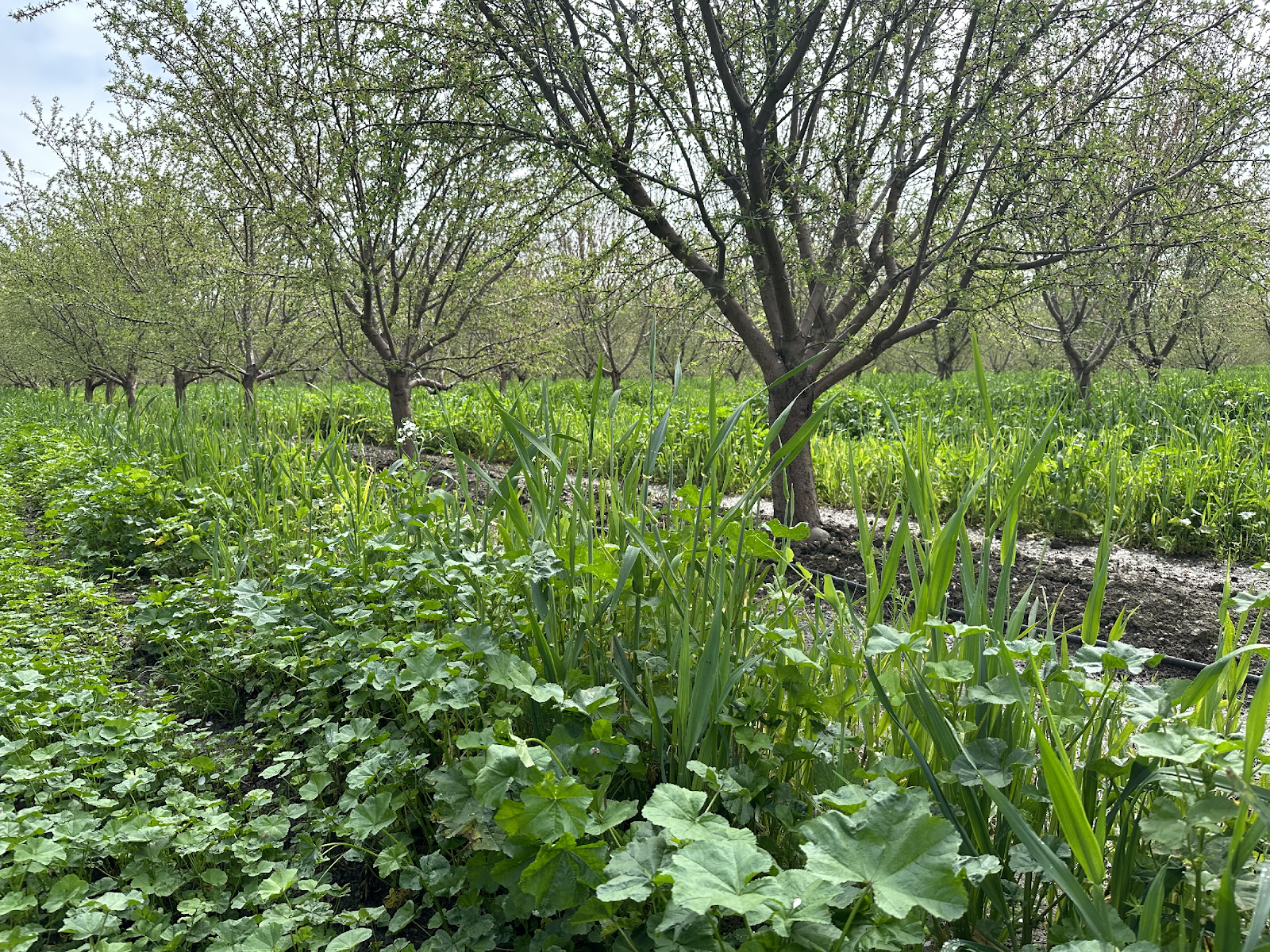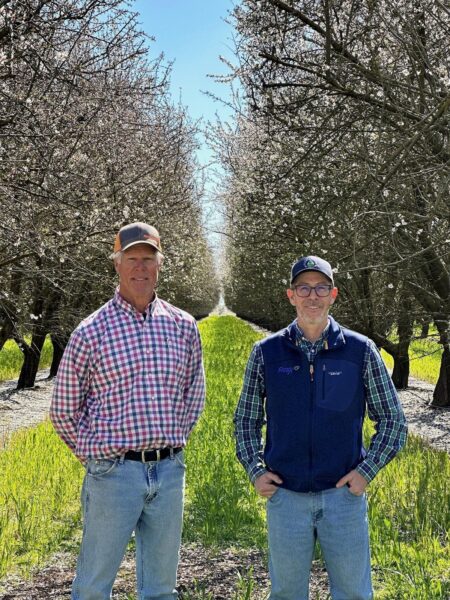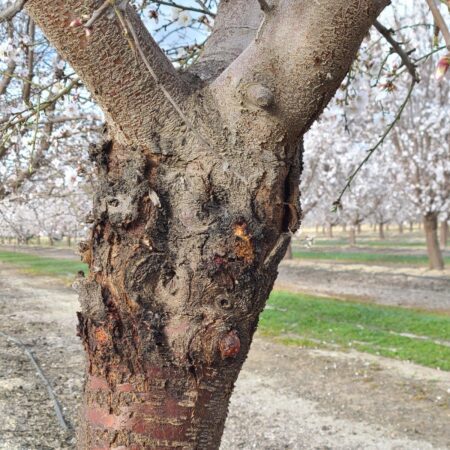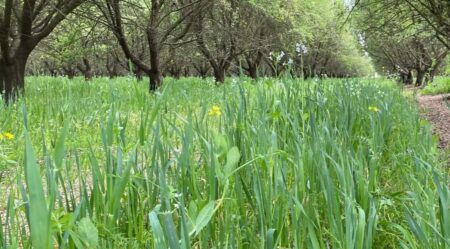

Ben (left) and Jerel (right).
As of 2022, there are over 1.6 million acres of almonds in California with a crop value of over $3.5 billion, making it the third or fourth highest value crop in the state depending on the year. The overwhelming majority of almonds are grown conventionally, with a small percentage being organic and an even smaller fraction of that being what could be called “regenerative”. Because almonds require a significant amount of water and nitrogen to grow a profitable crop, they are probably the most criticized crop in California from an ecological standpoint.
In the last few years, almond growers have been struggling to survive due to skyrocketing operating costs and record low crop prices, causing them to look at other methods of farming almonds to maintain profitability. Among practices being looked at are cover crops, compost, biologicals and biostimulants. But these practices are almost always looked at as an ancillary add-on to a standard conventional program rather than as tools that work together in a holistic manner to regenerate plant and soil life.
Ben Schroeder, a long-time almond farmer from Wasco, CA, began experimenting with soil biology in 2018 by trying some “bugs in a jug”. He didn’t see any results, which is not surprising. Most companies are selling lab-grown bacteria or a couple strains of fungi and asking farmers to add it on top of their existing program without focusing on soil microbial diversity or a big picture soil health changes. He also tried a few local compost teas and worm tea extracts in 2019 and 2020 that didn’t move the needle either.
One of the fields he was trying to turn around was an older 52-acre block that had serious water penetration problems and several almond disease pathogens that were not being controlled through conventional chemistry. Yields would fluctuate depending on the quality of water or amount of standing water each year, with the worst year only producing 1900 lbs. per acre of Nonpareil variety and 2100 lbs. Monterey variety (the county average in this area is usually around 2500 lbs/acre most years, with top producers being above 3000 lbs./acre). The orchard was full of Phytophthora root rot, bacterial canker, hull rot and Alternaria, and he was contemplating bulldozing it and starting over. He had spent years on conventional chemistry, fungicides, nutritional products, and soil health products to no avail.

Picture of a young almond tree with bacterial canker
One of the reasons for all the disease in this orchard was that there was standing water in the orchard for a day or more after irrigation was applied. Ben had spent years chasing better infiltration by using gypsum and surfactants from the big national ag chem suppliers. Water penetration is an issue due to poor soil health and structure, from maintaining bare orchard floors, repeated herbicide use, high salt fertilizer use, and multiple passes with heavy equipment.
Back in 2018, I advised Ben to stop applying gypsum to this orchard because the soil test showed plenty of available calcium. Continually adding gypsum over decades was adding to the sulfate-salt load in the soil. In 2019 and 2020, Ben tried soil surfactants and penetrants, along with the compost teas and biological extracts, but those also didn’t work (plus I wonder what effect these alcohol and petroleum-based chemicals have on soil biology?). Both gypsum and soil surfactants are standard practices in California almonds due to widespread water penetration problems.
Ben had another almond orchard he was considering transitioning to organic around this same time. Here, we started experimenting using Earthfort’s Provide and Revive biological products in 2019 and again in 2020, with phenomenal success (see link to previous almond case studies). Because that went so well, we began the three-year organic transition process on this orchard in fall 2020. The organic program included the Provide, Revive, local compost, and a very diverse cover crop mix from Green Cover Seed.
This success then propelled Ben to let me make changes to all his conventional orchards including the sick one mentioned at the beginning of the story. He started by using around 6 gallons Provide and 6 lbs. Revive spread out over 6 applications in the growing season, on top of his existing conventional program, without making any changes to the chemical approach. One year in, this didn’t seem to affect anything, and the yields continued to decline.
Then, in 2021, I revised the timing of the Provide and Revive program to late fall and early spring applications, but used the same total rate per acre, and had Ben drill in a custom Green Cover Seed nine-species cover crop mix like we did in the organic orchard. He also slowly began changing his fertilizer program by removing as much nitrate/salt containing fertilizers as possible.
In this first year of proper transition, water penetration began to improve some and I could see the soil was changing, but the diseases were still present. After harvest in 2021, the trees were full of fruit buds, which hadn’t been the case in previous years. In 2022, I significantly reduced the synthetic nitrogen by more than 50%, used more protein and amino acid-based materials, continued with Provide and Revive, and again drilled in a cover crop.
The yield on this block for 2022 was over 3500 lbs per acre averaged for both varieties, with the Monterey coming in at over 3800 lbs per acre. What was once his lowest yielding field was now his highest yielding field.
The state average for almonds in 2022 was around 1900 lbs./acre, with the industry reporting widespread reduced yields and significantly smaller sized kernels which resulted in lower weights per kernel. The general feeling among almond growers in Ben’s area was that this was the result of the serious drought over the last several years and the lack of snowmelt water from the Sierras forcing growers to pump salty, poor-quality groundwater. For Ben, however, his soil health had improved so dramatically that the trees performed as if it was a bumper crop year! Almond prices at the end of 2022 (and now into the end of 2023) are at extremely low prices, and unless the price comes up many growers will lose money per acre, yet Ben is hopeful to be profitable thanks to his soil health journey.

But the story doesn’t end with yield increases. Ben also saw a dramatic decrease in Phytophthora root rot and bacterial canker, and the Alternaria and hull rot completely disappeared. His trees, which used to ooze sap out of almost every tree trunk, cleaned up nicely. Water penetration went from less than 6 inches to over 3 feet, without any gypsum or surfactants, but instead using biology, cover crops, and dramatically reducing salt-based fertilizers.
Because we kept the cover crop all the way into June (rather than terminating in March like most growers do), we had more beneficial insects to keep most pests in check which resulted in significantly less pesticides used. Herbicide use dropped also because we kept the ground covered for as long as possible (and just as I’m writing this, I got a call saying that less soil was shipped off with the almond crop this year than ever before because the cover crop held the soil in place when the sweepers went through to pick up the nuts). And overall water use decreased by close to 20%. These are all huge wins for farmers, the environment, and consumers, and show that regenerative almonds are not only possible but highly profitable.
When the floods came to California in March 2023, it became clear which fields had healthy soil and which ones didn’t. Orchards that were cover cropped had amazing water infiltration and you could get in to work just a few days later, but “clean” bare orchards had water sitting in them for weeks on end.

Poso Creek flooding in March 2023.

Same flood, same day, across the street, but with robust cover crop establishment allowing water to infiltrate.
This kind of change is hard, and a lot of farmers start when they are backed into a corner, like Ben was with this field. That said, it doesn’t have to be that way. Now Ben has his entire operation on this program, including a fully organic orchard, and is starting new orchards on this regenerative path from the beginning. In late 2022, he planted a new field of almonds and incorporated ProVide, ReVive amino nitrogen, a custom Green cover nine-species cover crop mix, and adjustments to his other inputs. He believes this is the future, and we don’t know what the potential limit is.
Also check out the 11th edition, our latest Soil Health Resource Guide, over 90 pages packed with scientific articles and fascinating stories from soil health experts, researchers, farmers, innovators, and more! All as our complimentary gift to you, a fellow soil health enthusiast!This article first appeared in the 10th Edition of Green Cover's Soil Health Resource Guide.
